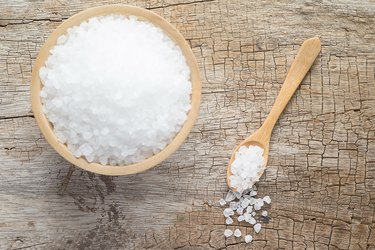
Love tomatoes but hate the way they upset your stomach? Certain acidic foods, such as tomatoes and citrus fruits, can cause gastrointestinal distress when cooked. To cut acidity in your dishes, counter your recipes with basic, alkaline ingredients to make them easier on the digestive system.
Video of the Day
Video of the Day
Acidic Foods in Your Diet
Foods fall into either acid or alkaline categories. A food measures as acid when the pH ranges from zero to 6.9, neutral at 7 and alkaline or basic at 7.1 or 14.0. Most fruits and vegetables fall in the alkaline category, but release acid when heat gets applied in cooking. Other acid foods include meats, poultry, eggs, dairy, grains, nuts and alcohol.
You won't necessarily earn health benefits by following an alkaline diet, but for those with dodgy stomachs, lowering your acid intake can help with digestion. Plus, according to an April 2016 review from Food & Nutrition, eating alkaline foods can help you with dropping your rates of cardiovascular disease, cancer and chronic diseases.
To cut acidity in cooking, you can experiment with mellowing out dishes by following these cooking ideas:
What you'll need:
- Sugar
- Baking soda
- Slow cooker
- Potatoes
- Sea salt
- Add sugar and baking soda in tomato sauce and tomato soup. The baking soda changes the pH of tomato sauce, creating a less acidic dish, and sugar enhances the sweetness to create a multi-dimensional flavor profile. For those with a sweet tooth, try adding sugar one-quarter teaspoon at a time until you reach your desired level of confectionary flavor.
- When baking bread, mix baking soda and sea salt with your ingredients. Baking soda has a pH of approximately 8.3, according to the U.S. National Library of Medicine, and will again transform the pH level, as well as leaven the bread. Sea salt has a pH of approximately eight and adds a different texture than what table salt offers. In addition, a 2017 study from Food & Nutrition Research found that natural sea salt consumption can protect against kidney hypertension and damage.
- To make lemonade, use 1 cup of sugar and 64 ounces of water for every cup of lemon juice. This allows the sugar sweetness and the neutral pH of water to offset the tart acid of the lemon juice.
Plus, lemon is good for you. According to a 2014 study from the Journal of Nutrition and Metabolism, lemon intake is effective for counteracting high blood pressure.
- To cook vegetables, simmer them on low heat for a longer period of time using a slow cooker. For example, simmer a vegetable stew in a slow cooker for 6 to 8 hours rather than simmering the dish for an hour on the stove. A slow cooker takes approximately 6 hours to reach the 209 degree Fahrenheit simmering point compared to 30 to 40 minutes on a stove.
Concerned about using a slow cooker? The USDA found that slow cookers are safe to use and can destroy bacteria with its leisurely cooking method. - Roast your vegetables. According to an October 2019 report from Harvard Health Publishing, roasting can make vegetables sweeter and allows the natural sugars to come out and caramelize. Roasting will also allow you to heat your vegetables without bringing out too much acid.
- Add potatoes to tomato-based sauces. You can cut and peel a potato, drop the vegetable into the sauce and remove it after 30 minutes. The potato will soak up some of the acid.
- Food & Nutrition: “Alkaline Diet: Does pH Affect Health and Wellness?”
- Harvard Health Publishing: "What to Eat When You Have Chronic Heartburn"
- U.S. National Library of Medicine: "Sodium Bicarbonate"
- Food & Nutrition Research: "Natural Sea Salt Consumption Confers Protection Against Hypertension and Kidney Damage in Dahl Salt-Sensitive Rats"
- USDA: "Slow Cookers and Food Safety"
- Journal of Nutrition and Metabolism: "Effect on Blood Pressure of Daily Lemon Ingestion and Walking"